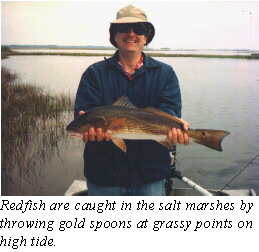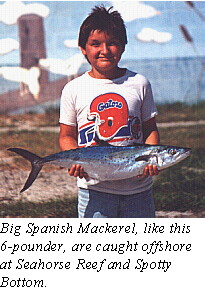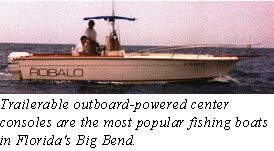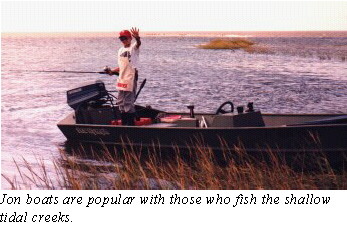

Most GOFC members fish the northeastern Gulf of Mexico in a region known as Florida's Big Bend. Club records are kept for (and tournament fishing is limited to) the area of the Big Bend between Homosassa and Steinhatchee in waters of 80 feet deep or less. The Gulf of Mexico is very shallow in the Big Bend, and the bottom drops off at a rate of 2 feet per mile. To reach a depth of 80 feet requires a trip of about 40 miles offshore!
 The Big Bend is an "oyster
coast." White sandy beaches are rare, as is the crowding and
development that accompanies them. Most of the coastline consists
of a salt marsh penetrated by shallow, muddy to rocky tidal
creeks. These merge into broad, shallow beds of coastal sea
grasses that extend for several miles offshore. Beyond the grass
beds are miles and miles of barren sandy bottom interrupted by
occasional to frequent rocky outcrops full of fish.
The Big Bend is an "oyster
coast." White sandy beaches are rare, as is the crowding and
development that accompanies them. Most of the coastline consists
of a salt marsh penetrated by shallow, muddy to rocky tidal
creeks. These merge into broad, shallow beds of coastal sea
grasses that extend for several miles offshore. Beyond the grass
beds are miles and miles of barren sandy bottom interrupted by
occasional to frequent rocky outcrops full of fish.
Some GOFC members regularly fish the Atlantic Ocean from Jacksonville to Fort Pierce, with most activity taking place at St. Augustine. The club keeps no records from the Atlantic Ocean and holds no tournaments there, although we occasionally participate in multi-club tournaments organized by Atlantic coast clubs.
 Most GOFC members are trailer boaters,
although owning a boat is not a prerequisite for joining the
club. The most common configuration is an outboard-powered center
console between 16 and 25 feet in length. Outboard-powered
walk-around cuddy cabins, 20 to 25 feet in length, are the second
most popular configuration. I/O power is less commonly used, and
true inboards are rare because of their increased risk of
grounding in our shallow channels. Inshore fishermen favor jon
boats or air boats for travel far up shallow tidal creeks in
search of redfish. Flats boats are increasing in popularity,
especially around Homosassa.
Most GOFC members are trailer boaters,
although owning a boat is not a prerequisite for joining the
club. The most common configuration is an outboard-powered center
console between 16 and 25 feet in length. Outboard-powered
walk-around cuddy cabins, 20 to 25 feet in length, are the second
most popular configuration. I/O power is less commonly used, and
true inboards are rare because of their increased risk of
grounding in our shallow channels. Inshore fishermen favor jon
boats or air boats for travel far up shallow tidal creeks in
search of redfish. Flats boats are increasing in popularity,
especially around Homosassa.
 The waters in the Big Bend are relatively calm and
sheltered. Persistent wind is sometimes a problem in the winter
and spring, when only about one day in four is calm enough to
fish offshore in comfort, although you can fish inshore most
days. There are no nasty inlets to run, and anglers usually take
delight in our typical summer and autumn wind patterns -- at your
back when going out in the morning and at your back when
returning in the evening. Because the Gulf is so shallow in the
Big Bend, the waves that blow up on a windy day tend to be very
steep-sided and close together. Even a 3-foot chop of this sort
can be very miserable.
The waters in the Big Bend are relatively calm and
sheltered. Persistent wind is sometimes a problem in the winter
and spring, when only about one day in four is calm enough to
fish offshore in comfort, although you can fish inshore most
days. There are no nasty inlets to run, and anglers usually take
delight in our typical summer and autumn wind patterns -- at your
back when going out in the morning and at your back when
returning in the evening. Because the Gulf is so shallow in the
Big Bend, the waves that blow up on a windy day tend to be very
steep-sided and close together. Even a 3-foot chop of this sort
can be very miserable.
 The other weather risk is lightning. Small, but
violent, thunderstorms with frequent lightning and heavy rains
are common in summer and should be treated with respect. However
the storms typically form up at the shore line and proceed to
march inland, away from the fisherman. Storms that form up
offshore are often only a few miles in diameter, and it is common
practice to circle around behind them in all but the slower or
smaller boats.
The other weather risk is lightning. Small, but
violent, thunderstorms with frequent lightning and heavy rains
are common in summer and should be treated with respect. However
the storms typically form up at the shore line and proceed to
march inland, away from the fisherman. Storms that form up
offshore are often only a few miles in diameter, and it is common
practice to circle around behind them in all but the slower or
smaller boats.
The sea temperature in the Big Bend varies from a mid winter low of about 55 degrees to a late summer high of about 88 degrees, thus temperatures are suitable at any time of the year for one or more species of fish to be biting both inshore and offshore. Offshore springs and the discharge from many spring-fed rivers may further moderate the winter temperatures in local areas, creating concentrations of fish. Winter mornings can be cold enough to require a coat, hat and gloves, but by afternoon it usually warms up into the 60s. Mid day temperatures during summer can be brutal. Heat exhaustion is always a risk and anglers should fish from boats having some sort of shade such as a T-top or a bimini. Sunburn is a hazard at any time of year, and liberal use of sun screen is always recommended.